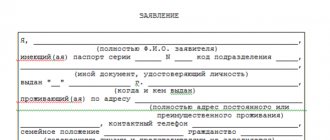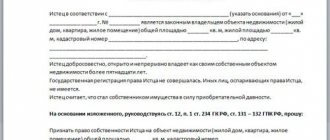What does this operation mean for the borrower?
If all the money has been paid to the bank, this does not mean the final transfer of the apartment into the ownership of the borrower. It is necessary to complete legal procedures with documents in order for the housing to become property . One of them is paying off the mortgage registry. The procedure and timing of this operation are established in Article 25 of Federal Law No. 102 “On Mortgage”.
Only when recording the removal of the encumbrance can the borrower be considered the full owner of the property he acquired.
Rosreestr in Moscow: how to pay off a mortgage record
The Moscow Office of Rosreestr and the Headquarters for Business Protection held a joint webinar on the topic: “Features of state registration of mortgages,” writes st-krukovo.mos.ru.
During the event, a representative of the capital's Rosreestr focused on the issue of types and grounds for the emergence of a mortgage. Thus, a mortgage by virtue of an agreement arises on the basis of a mutual agreement between the parties to the mortgage agreement; in order to register it, the mortgagee and the mortgagor must submit a joint application to Rosreestr and pay a state fee. A mortgage by force of law arises on the basis of a provision of law, i.e. the encumbrance in this case arises automatically, simultaneously with the state registration of the property rights of the person whose rights are encumbered by the mortgage. Its registration is carried out at the request of the pledgee or pledgor, and in this case the state fee is not charged.
In order to make a change to the mortgage record contained in the Unified State Register of Real Estate (USRN), it is necessary to submit an additional agreement to Rosreestr and pay the state fee in accordance with tax legislation. After the additional agreement is provided by Rosreestr in Moscow, a legal examination is carried out, based on the results of which a decision is made to make appropriate changes.
Procedure for repaying a mortgage registration record*
1. If a mortgage has not been issued, then the termination of the mortgage is carried out on the basis of a joint application of the mortgagee and the mortgagor, including an application of the mortgagee.
2. If a mortgage has been issued, then the termination of the mortgage is carried out, inter alia, on the basis of a joint application of the mortgagor and the legal owner of the mortgage with the simultaneous submission of a documentary mortgage or a statement of a depository account, provided that the documentary mortgage has been immobilized or an electronic mortgage has been issued.
In cases of liquidation of the mortgagee (for example, a bank), the registration record of the mortgage is canceled based on the application of the mortgagor and an extract from the Unified State Register of Legal Entities (USRLE), confirming the entry into the specified register of an entry on the liquidation of this legal entity. At the same time, it should be noted that in this case there is no need to attach an extract from the Unified State Register of Legal Entities, because the registrar itself requests this information as part of interdepartmental electronic interaction.
The mortgage registration record is cleared by the capital's Rosreestr within three working days from the moment the relevant application is received by the rights registration authority. You can watch the recording of the webinar by following the link. The Business Protection Headquarters was created with the aim of creating favorable conditions in the capital for conducting investment and business activities, developing and protecting competition, and ensuring guarantees of state protection of the rights and legitimate interests of representatives of the business community. It is headed by Moscow Mayor Sergei Sobyanin.
Procedure
After full repayment of the mortgage debt, the borrower must contact the bank branch, where, upon application, he is provided with a mortgage for the apartment. This document is issued by the bank within 10 days after the borrower applies. The mortgage must bear a note from the credit institution indicating that the entire amount of the debt has been paid.
The next step is to draw up an application. To carry out the procedure for canceling a registration record, one of the following grounds is required:
- statement from the borrower who has fully repaid the mortgage loan;
- a joint document between the mortgagor and the borrower;
- an application from a credit institution that has real estate as collateral;
- decision of a judicial authority.
This document, together with the rest of the documentation package, is submitted to Rosreestr. Moreover, if the mortgage agreement has not been notarized, then a joint application to the Rosreestr branch will be required: the borrower and the lender. If the procedure for certification of the mortgage agreement by a notary was carried out, then either party can submit an application. If the apartment was purchased as shared ownership, then an application to the Rosreestr of all owners of this housing is required. Otherwise, you need to issue a power of attorney.
After the 3-day period, the registration record will be canceled. In this case, a note indicating its invalidity must be made on the mortgage by affixing the Cancelled stamp on the front side. The canceled mortgage note is handed over to the mortgagor upon his request.
Redemption of a registration record established for an apartment purchased under a DDU, if the house is not yet in operation, is somewhat different from a regular mortgage. The title to the property was not registered and, therefore, no mortgage was also issued.
The collateral was not real estate, but the right of claim. In this situation, it is necessary to jointly apply to Rosreestr with an application from the borrower and the developer at the location of the building under construction. The following must also be provided: a certificate of debt repayment, an equity participation agreement, permission to put the building into operation and an act of transferring the object to the borrower. This procedure is carried out by the civil service within 5 days.
Attention! After the removal of the encumbrance in the form of a mortgage from the property, at the request of the owner, he can re-issue a certificate of ownership, in which there will be no record of the previous encumbrance.
We talked about what to do after paying off your mortgage here.
As a general rule, in order to redeem the mortgage record, the mortgagor and the mortgagee (the legal owner of the mortgage - when registering the mortgage) must apply jointly. The basis for expunging the record will be their application. However, in some cases, to terminate the mortgage, these persons may apply to the registration authority separately.
In this case, other supporting documents may be required, for example a mortgage when the mortgagor applies. The mortgage record is cleared within three working days from the moment the necessary documents are received by the registration authority. To confirm this, you can request an extract from the Unified State Register. Who and in what cases can apply for redemption of a mortgage record Redemption of a mortgage record can be applied for (clause 1 of Article 25 of the Mortgage Law): 1) if a mortgage has been issued: - jointly by the mortgagor and the legal owner of the mortgage; - legal owner of the mortgage; - pledgor; 2) if the mortgage is not issued: - jointly the mortgagor and the mortgagee; - mortgagee. The registration record of a mortgage is also canceled by a decision of a court or arbitration court to terminate the mortgage in the manner provided for in Art. 25 of the Mortgage Law. If the mortgage arose by virtue of the Law on Participation in Shared Construction, the record of it is canceled based on the application of the mortgagor-developer, as well as other documents submitted by him, given in clause 1.1 of Art. 25 of the Mortgage Law. In the event of liquidation of the mortgagee - a legal entity, the registration record of the mortgage is canceled on the basis of the application of the mortgagor and an extract from the Unified State Register of Legal Entities confirming the entry into this register of an entry on the liquidation of this legal entity (Part 14 of Article 53 of the Law on State Registration of Real Estate, Article 25.1 of the Law on Mortgage ). If the mortgage agreement (the agreement under which the mortgage arose by force of law) was certified by a notary, an application for repayment of the mortgage registration record is submitted to the registering authority by a notary (his assistant). This follows from Art. 86.1 Fundamentals of the legislation of the Russian Federation on notaries. To repay the mortgage when foreclosure on the mortgaged property, a separate application by any person is not required. The mortgage record will be canceled automatically upon registration of the property rights of the acquirer or mortgagee, if he leaves such real estate for himself (clause 4 of article 25 of the Law on Mortgage, clause 2 of article 50 of the Law on State Registration of Real Estate). 2. On the basis of what documents is the mortgage record cancelled? The grounds for canceling the mortgage record are the following documents (in some cases it is necessary to submit not one, but several of the documents listed below): 1) application (Part 11 of Article 53 of the Law on State Registration of Real Estate , clause 1 of article 25 of the Mortgage Law). 2) a documentary mortgage or statement of a securities account , provided that the documentary mortgage has been immobilized or an electronic mortgage has been issued (in the cases provided for in paragraph 1 of Article 25 of the Mortgage Law); 3) a court decision (arbitration court) , if the mortgage is repaid on its basis (clause 1 of article 25 of the Mortgage Law); 4) permission to put the facility into operation if the mortgage arose by virtue of the Law on participation in shared construction (clause 1.1 of Article 25 of the Law on Mortgage). This permission is necessary to repay the mortgage: - an apartment building under construction (created) and (or) other real estate, as well as an unfinished construction project; — land plot (pledge of lease rights, sublease of land plot). The developer can submit such a document on his own initiative. This follows from Part 6 of Art. 18 of the Law on State Registration of Real Estate. If the mortgage of a shared construction project is being repaid, you must additionally submit documents on the transfer of this object to the participant: a transfer deed (another transfer document) or a unilateral deed (clause 1.1 of Article 25 of the Mortgage Law). Note that the record of the mortgage of a land plot (lease rights, sublease of the land plot) is cleared only after the records of the mortgage of all objects of shared construction of an apartment building and (or) other real estate are cleared (Clause 1.1 of Article 25 of the Law on Mortgage ); 5) an extract from the Unified State Register of Legal Entities , if the pledgee organization is liquidated. The mortgagor submits such an extract on his own initiative (Part 14, Article 53 of the Law on State Registration of Real Estate, Article 25.1 of the Law on Mortgage). Keep in mind that when applying for termination of the mortgage, you will also need a power of attorney and other documents that confirm the powers and identity of the representative (director). The main list of documents that must be submitted to pay off the mortgage registration record in a particular case is given in Art. Art. 25 and 25.1 of the Mortgage Law. There is no need to pay the state duty for repaying the mortgage registration record (clause 6, clause 3, article 333.35 of the Tax Code of the Russian Federation). 3. How long does it take to repay the mortgage and how is this confirmed? The registration record of the mortgage is repaid within the following periods after the application is received by the registration authority (clause 1, 1.1 of Article 25 of the Mortgage Law): · 3 working days - as a general rule; · 5 working days - if the mortgage arose by virtue of the Law on Participation in Shared Construction. Redemption of a mortgage registration record does not constitute state registration of rights. Therefore, to confirm the termination of the mortgage, an extract from the Unified State Register is not issued and a special registration inscription is not affixed to the documents. This follows from Art. 28, paragraph 12 art. 53 of the Law on State Registration of Real Estate. If a mortgage note was submitted to pay off the mortgage record, the registration authority will cancel it. The former mortgagor can only receive a canceled mortgage (clause 7, article 17, clause 3, article 25 of the Mortgage Law). If you need to confirm the repayment of the mortgage record, request an extract from the Unified State Register of Real Estate (Part 6, Article 62 of the Law on State Registration of Real Estate).
Documents to be prepared
To remove the encumbrance from the purchased property, the following documents will be required:
- application for registration of repayment;
- applicant's passport;
- power of attorney if the procedure is carried out by a legal representative;
- a document evidencing the purchase of an apartment - a purchase and sale agreement or a transfer deed for a residential building;
- a document on which restrictions have been imposed - a certificate of ownership or a share participation agreement;
- mortgage note, original only;
- certificate of full repayment of the mortgage;
- permission to commission a building for preschool education.
When submitting an application, you must include the following items:
- The header of the application indicates the authority to which the document is sent and from whom it was drawn up.
- The text of the application must contain a request to remove the registration record. It must be indicated that all obligations to the creditor have been fulfilled. Enter the date when this happened.
- The document must indicate information about the property from which the encumbrance is required to be removed, and details of the mortgage loan: its number and date.
- At the end, the signatures of the applicants and their contact information are affixed.
Read about the documents that need to be prepared, as well as where to submit them to remove the encumbrance, here.
The Supreme Court told which court will terminate the mortgage
Russian legislation places disputes over rights to real estate under exclusive jurisdiction (Part 1, Article 30 of the Code of Civil Procedure, Parts 1, 2, Article 38 of the Arbitration Procedure Code). They are sent to the court at the location of the real estate. This facilitates the work of the court in collecting and examining evidence, which, in the opinion of the legislator, should help quickly and correctly resolve the dispute, explains Pavel Khlustov, Pavel Khlustov and Partners.
In addition, the resolution of such a dispute may affect the rights and interests of third parties who have proprietary or liability rights to this property. With exclusive jurisdiction, they have an additional opportunity to receive timely information about the emergence of a dispute, says Khlustov. “And the court itself is better informed. He has more opportunities to learn about the rights and interests of third parties not involved in the case.”
Exclusive jurisdiction
A special type of jurisdiction that prescribes the consideration of certain categories of cases in courts precisely specified in the law. The rules of exclusive jurisdiction prohibit the application of the rules on other types of territorial jurisdiction contained in Art. 28, 29, 31, 32 Civil Procedure Code.
Mortgage: correct jurisdiction
The jurisdiction of a dispute periodically causes difficulties for the courts. This time the dispute over jurisdiction was related to the mortgage. The case was brought to the civil disputes panel of the Supreme Court from the Novosibirsk regional court. As indicated in the materials, in 2005, Ivan Goryachev* and Pyotr Chudkov* entered into a loan agreement (the amounts are not indicated in the acts). As security, Inna Melnichenko* pledged her apartment in Novosibirsk. Five years later, in 2010, the court collected the debt and foreclosed on the housing. The decision to collect came into force, but the enforcement officers did not present them on time. The deadline has passed.
- Jurisdiction with an error: when it can be made
July 2, 8:55
Therefore, Melnichenko wanted to recognize the real estate pledge as terminated. Having decided that the case had exclusive jurisdiction, the plaintiff appealed to the Kirovsky District Court of Novosibirsk - at the location of the subject of the mortgage. Two authorities refused to consider the case and concluded that there was a violation of jurisdiction. They indicated that the claim should have been filed not with exclusive jurisdiction, but at the place of residence of the defendants. But this approach is erroneous, the Supreme Court concluded.
The panel, chaired by Judge Vyacheslav Gorshkov, recognized that we are talking about exclusive jurisdiction. It applies to claims challenging the encumbrance of real estate. The Supreme Court indicated how to justify this in its judicial act (No. 67-KG20-2). It says that according to Part 1 of Art. 30 of the Civil Procedure Code, claims must be filed in the court at the location of the objects or seized property for rights to land plots, subsoil plots, buildings, including residential and non-residential premises, structures, structures, and other objects firmly connected to the land. The same applies to claims for the release of property from seizure.
The Supreme Court referred to the joint Resolution of the Plenum of the Supreme Court and the Supreme Arbitration Court dated April 29, 2010 No. 10/22 on issues in disputes over the protection of property rights. It explained what applies to claims for rights to real estate. This category includes (in addition to claims for the recovery of property from someone else’s illegal possession, for the elimination of violations of rights not related to deprivation of possession, for the recognition of rights, for the establishment of an easement, the boundaries of a land plot) also claims for the release of property from arrest (clause 2 ). The Supreme Court concludes: therefore, exclusive jurisdiction is established for claims for any rights to real estate, therefore it is not so important whether they are related to deprivation of possession or not. Since the given list of claims for rights to real estate is not exhaustive, it can include cases challenging the encumbrance of real estate, the judicial act emphasized. That is, this includes the mortgage claim in question.
“A real estate pledge (mortgage) is an encumbrance on property, and the dispute about recognizing the pledge as terminated is related to the rights of the disputing parties regarding this real estate,” the Supreme Court said.
The Supreme Court clarified: when foreclosure on mortgaged real estate there is no dispute about the rights to this property, and the basis for the claim is a violation of the obligation secured by the mortgage, that is, ordinary jurisdiction. But claims for termination of a mortgage relate to claims for rights to real estate, and therefore are considered with exclusive jurisdiction. The Supreme Court overturned the judicial decisions and sent the claim to the first instance to decide whether to accept it for proceedings.
Jurisdiction: five controversial issues
Jurisdiction of a corporate dispute on declaring a transaction invalid and applying the consequences of the invalidity of a real estate transaction
Provisions Part 1, 2 Art. 38 of the APC on the exclusive jurisdiction of claims for rights to real estate may conflict with the norm of Part 4.1 of Art. 38 of the APC, which establishes exclusive jurisdiction for corporate disputes (see Art. 225.1 of the APC). A corporate dispute must be considered by the court at the location of the legal entity, and the location of the disputed real estate may differ. Uncertainty arises in determining the arbitration court competent to consider the dispute.
The issue of the relationship between the jurisdiction of a dispute over rights to real estate and a corporate dispute was resolved at the level of the Presidium of the Supreme Arbitration Court: in the event of a conflict, the rules of jurisdiction over rights to real estate take precedence (Resolution of September 7, 2010 No. 6470/10).
Considering the issue of jurisdiction of a corporate dispute regarding the invalidation of a mortgage agreement and the repayment of the mortgage registration record in the Unified State Register, the Presidium of the Supreme Arbitration Court indicated: since the main purpose of the claim is to recognize the encumbrance as absent, the dispute is actually a dispute about the rights to real estate. The Presidium of the Supreme Arbitration Court deliberately focused on the fact that the plaintiffs simultaneously stated two demands - not only the demand to invalidate the mortgage agreement, but also the demand to cancel the mortgage registration record. “The Presidium of the Supreme Arbitration Court had in mind that if the plaintiff had limited himself only to the demand for recognition of the contract as invalid, then the dispute would not have fallen under the criteria of Parts 1, 2 of Art. 38 of the APC on the exclusive jurisdiction of claims for rights to real estate. The territorial jurisdiction of a corporate dispute containing only a requirement to challenge a real estate transaction would be subject to the rule of Part 4 of Art. 38 of the APC, that is, the dispute would have to be considered by the arbitration court at the location of the legal entity,” notes Pavel Khlustov.
Jurisdiction of a dispute regarding the fulfillment of obligations to pay for real estate
The dispute over the fulfillment of obligations to pay for purchased real estate does not fall under the provisions of Art. 38 of the APC on exclusive jurisdiction, follows from the Resolution of the Presidium of the Supreme Arbitration Court of December 20, 2011 No. 9924/11. The reason is that if the court upheld the seller’s claim and ordered the buyer to pay, such a decision, neither directly nor indirectly, cannot be considered as stipulating that upon its execution the transfer of the right to real estate or making another entry in the Unified State Register must be registered. “The rule on the territorial jurisdiction of disputes regarding the collection of overdue debts in real estate transactions should be universal and not limited to disputes arising only from the purchase and sale agreement,” Khlustov points out.
Jurisdiction of a dispute regarding the establishment of an easement
The claim for the establishment of an easement falls under the provisions of Art. 38 of the APC on exclusive jurisdiction and is considered at the location of the real estate. This follows from the explanations in paragraph 1 of the Resolution of the Plenum of the Supreme Arbitration Court of October 12, 2006 No. 54 and paragraph 2 of the Resolution of the Plenum of the Supreme Arbitration Court and the Plenum of the Supreme Arbitration Court of April 29, 2010 No. 10/22. The same legal position is contained in the Determination of the Economic College of the Supreme Court No. 301-ES14-9021. Claims for termination or modification of the terms of the easement must also fall under the provisions of Art. 38 of the AIC, Khlustov believes.
Jurisdiction of a dispute regarding foreclosure of a land plot within the framework of enforcement proceedings
Foreclosure of land plots within the framework of enforcement proceedings is allowed only on the basis of a court decision. Such cases are considered in the manner of claim proceedings and in compliance with the rules of exclusive jurisdiction (Article 30 of the Code of Civil Procedure and Article 38 of the Arbitration Procedure Code). In this case, the claimant and the bailiff have the right to submit such a claim to the court.
Jurisdiction of a dispute regarding foreclosure of mortgaged real estate
The issue of exclusive jurisdiction of such disputes was resolved in different ways. The Supreme Arbitration Court took the position that the claim should be attributed to disputes about rights to real estate. This legal position prevailed in arbitration courts, although there were judicial acts with the opposite opinion.
But the Constitutional Court took the opposite point of view. In Resolution No. 10-P KS dated May 26, 2011, he explained that a dispute about foreclosure on mortgaged real estate is not a dispute about the rights to this property, since its subject is the implementation of actions, the result of which should be the transfer of money (clause 5.1) . The court decision itself does not entail the transfer of rights to the mortgaged real estate, the Constitutional Court indicated (clause 5.3).
The Presidium of the Supreme Court confirmed this approach in matters of foreclosure on mortgaged real estate in civil proceedings (clause 2.1 of the “Review of judicial practice in civil cases related to the resolution of disputes regarding the fulfillment of loan obligations”, approved by the Presidium of the Supreme Court of the Russian Federation on May 22, 2013). Later, the approach began to take root in the practice of arbitration courts.
* – the names and surnames of the parties to the dispute have been changed.
When and where to contact?
To remove the registration record, you should contact Rosreestr. In this case, the operation will be carried out within 3 days with a regular mortgage and within 5 days with a DDU. You can also contact the MFC. In this case, the procedure for removing the burden will be extended by 2 days.
Redemption of the registration record is carried out only after depositing all funds that were received by the borrower from the lender, or by a court decision.
Rosreestr carries out registration of this procedure free of charge, state duties are not charged. After paying off the entire amount that was received as borrowed funds, it is required to clear the registration entry on the existence of an encumbrance on the purchased property. To do this, you need to contact the bank to obtain a mortgage note with a note about the repayment of the mortgage debt, then send an application to the Rosreestr branch to remove the registration record from the property.
Only when these operations are carried out will the apartment become property without any encumbrances.
Read about how mortgage encumbrances are lifted at the MFC, Rosreestr or through the State Services website, and how to do it correctly after full payment of the loan.
Documents at the MFC for removing the mortgage encumbrance on an apartment
Documents for removing the encumbrance are listed in the Federal Law “On Mortgage (Pledge of Real Estate)” in Article 25 “Redemption of the mortgage registration record.” MFC “My Documents” only accepts applications; the mortgage registration record is removed at the Office of the Federal Service for State Registration, Cadastre and Cartography. Abbreviated as Companies House. After this, the documents are sent back to the MFC, where they can be picked up.
More information about removing the encumbrance from an apartment after paying off the mortgage is written on the website Prozhivem.com - https://prozhivem.com/kvartira/drugoe/kak-snyat-obremenenie-posle-vyplaty-ipoteki. The documents were taken from there. The current list for 2021 is:
- Passport;
- Loan agreement ; The agreement must be in the hands of the borrowers. If you have lost it, you can get a copy from the bank.
- Certificate of mortgage repayment ; The full name of the certificate is usually “Certificate of termination of obligations under the Mortgage Agreement.” It is issued by the bank. For some banks, the application can be submitted through their application; some banks accept the application only at the branch itself. Take your passport and loan agreement with you. Help is free. Usually it is given on the day of application, but for some banks it may take several days. It is better to consult your manager about the timing.
- Mortgage ; The mortgage is also issued by the bank and is usually kept in a depository. As soon as the mortgage repayment certificate is issued, you can write an application for a mortgage. It is usually issued within 2 weeks to 2 months.
- Power of attorney to remove the encumbrance ; According to the law, bank representatives must, together with the borrowers, submit documents to the MFC to remove the encumbrance. Instead, some banks issue a power of attorney for borrowers to submit an application to the MFC. This is normal practice. Typically, a power of attorney is issued along with a mortgage. In most cases, the service is free, but it is better to check with the manager.
- If instead of the borrowers, documents are submitted to the MFC by an authorized person, then a notarized power of attorney is required from the principals (borrowers).
There is no state fee for removing the encumbrance. According to clause 1 of Article 25 “Repayment of the mortgage registration record”, the encumbrance is removed within 3 working days. In practice, longer, because this period begins after Companies House receives documents from the MFC. This transfer of documents takes 1-2 days. Also, a lot depends on the workload of the MFC branch itself or on the workload of the Registration Chamber.
The presence of an encumbrance on an apartment can be viewed on the Rosreestr website - instructions with pictures.
The material was provided by the lawyer of the project “Let’s Live.com”.





